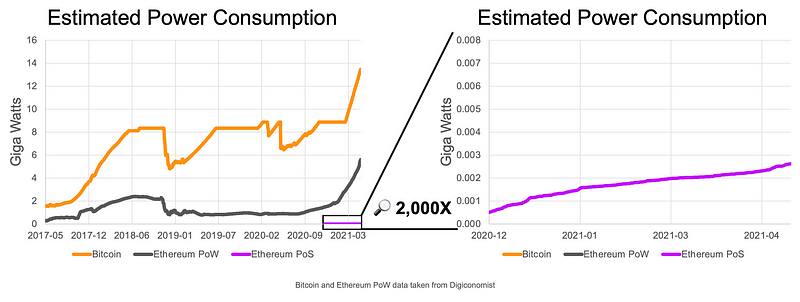# Understanding the Shift to Ethereum's Proof-of-Stake for Sustainability
Written on
Chapter 1: Introduction to Consensus Mechanisms
On May 27, 2021, Vitalik Buterin, the visionary behind Ethereum, reaffirmed the platform's transition from a proof-of-work (PoW) framework to a proof-of-stake (PoS) model, with the goal of minimizing carbon emissions. The Ethereum Foundation confirmed that the complete transition would be finalized by the end of 2021.
This reiteration was crucial, especially after Elon Musk's controversial tweet about halting Bitcoin payments for Tesla due to environmental concerns, which sparked anxiety among crypto investors. Buterin's commitment to move Ethereum to PoS offered some reassurance.
This prompted me to explore the fundamental differences between Proof of Work and Proof of Stake in the cryptocurrency realm, particularly addressing the energy consumption issues related to PoW. This article aims to simplify these concepts and present them in a more digestible format.
Section 1.1: Defining Consensus Mechanisms
Before diving into PoW and PoS, it’s essential to understand what consensus mechanisms are. Simply put, consensus refers to reaching a general agreement. In centralized systems, banks validate transactions under government authority, whereas decentralized systems, like cryptocurrencies, depend on autonomous entities to manage and authenticate transactions. Consequently, these networks utilize common cryptographic algorithms to achieve consensus.
Subsection 1.1.1: What is Proof of Work?
Many technology advocates regard Bitcoin as one of the most groundbreaking inventions of the 21st century. With Bitcoin's introduction in 2008, PoW became the prevailing algorithm for cryptocurrencies. Miners, who maintain the distributed ledger, manage networks of computers to solve intricate mathematical equations. The first miner to solve the equation gets to add a block of transactions to the chain, creating a verified transaction on the immutable PoW blockchain. They are rewarded with cryptocurrency for their efforts.
While PoW has effectively secured Bitcoin and Ethereum for years and is relatively straightforward to implement, it presents several challenges: accessibility, centralization, and scalability.
Accessibility: Mining Bitcoin is no simple task. It requires understanding the constantly evolving technology and assembling large mining operations with significant computational power, which is energy-intensive.
Recent statistics indicate that China accounted for over 65% of Bitcoin mining in 2020, primarily due to its low energy costs and skilled workforce. This dominance can hinder other nations from participating in mining, leading to further centralization.
Centralization: The fundamental principle of cryptocurrency is to maintain a decentralized ledger. However, if mining becomes exclusive to wealthy entities, like Chinese miners, it undermines this principle.
Scalability: In the current PoW setup, blocks are mined sequentially, each with a limited data capacity. If high transaction volumes exceed the block size, users may experience delays.
Section 1.2: What is Proof of Stake?
PoS introduces a different consensus mechanism where users stake their cryptocurrency to become validators within the network. Validators are responsible for proposing and confirming blocks in the PoS blockchain.
Once consensus is achieved, the block is added to the chain, and validators earn rewards similarly to PoW, while malicious activities are penalized. PoS addresses the challenges of PoW without harming the environment.

Accessibility: In PoS, validators don’t face the initial hardware and energy costs associated with mining. However, a minimum stake is required to operate a full validator node.
Centralization: PoS only necessitates a small amount of cryptocurrency, an internet connection, and a laptop, allowing smaller players to participate and supporting the principle of decentralization.
Scalability: PoS can manage scalability efficiently while maintaining security, utilizing a method called sharding to process transactions in parallel.
As numerous altcoins emerge in the crypto space, alongside the dominance of Bitcoin and Ethereum, Buterin feels a significant responsibility.
“This endeavor we’re pursuing has evolved beyond a mere game; it represents a pivotal element of a new era.”
Chapter 2: Insights from Experts
In this section, we will explore expert opinions on the transition to PoS.
In the video titled Ethereum 2.0: Proof of Stake vs Proof of Work | Vitalik Buterin and Lex Fridman, Vitalik discusses the critical differences between PoW and PoS, shedding light on Ethereum's future.
Another insightful video, Ethereum - Tutorial 6 - Proof of Stake vs. Proof of Work Explained, provides a clear explanation of how these mechanisms function and their implications for the crypto ecosystem.
References
- PROOF-OF-STAKE (POS)
- A country's worth of power, no more!
- What Is Proof of Stake?
If you found this piece interesting, you might also enjoy my other introductory articles on cryptocurrency, such as:
- The First Dogecoin Millionaire of 2021
- NFTs Are Blowing up the Art World